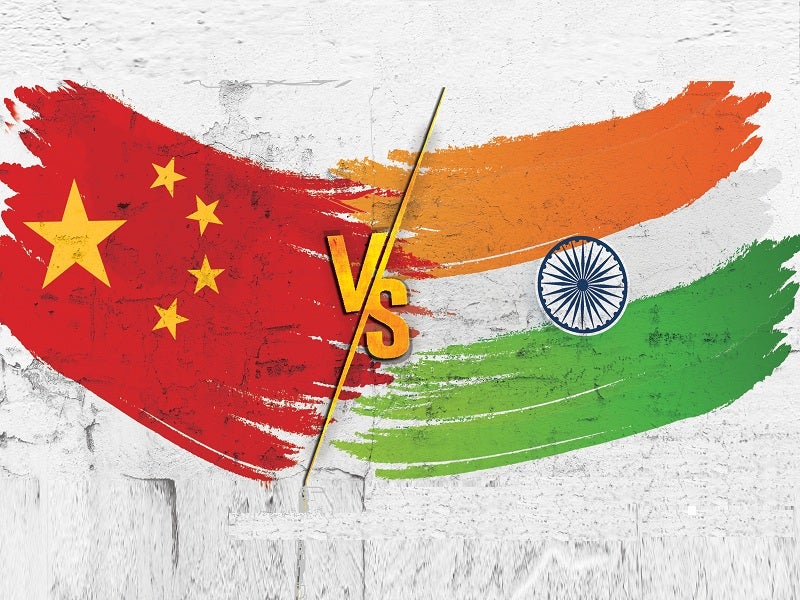
Comparing India vs China Airpower
The Chinese Air Force, the People’s Liberation Army Air Force (PLAAF), is stronger compared with the Indian Air Force (IAF) in terms of fleet and strategic inventory, but the IAF deploys more reliable platforms and strategic bases, combined with experienced troops.
This analysis is based on available facts and technical specifications; the actual performance of the forces and aerial assets may vary based on the skills and adaptability to actual conditions.
How well do you really know your competitors?
Access the most comprehensive Company Profiles on the market, powered by GlobalData. Save hours of research. Gain competitive edge.

Thank you!
Your download email will arrive shortly
Not ready to buy yet? Download a free sample
We are confident about the unique quality of our Company Profiles. However, we want you to make the most beneficial decision for your business, so we offer a free sample that you can download by submitting the below form
By GlobalDataAreas in which China is stronger
- PLAAF is the second biggest air force in the world whereas IAF is the fourth largest.
- PLAAF’s mammoth fleet of fighter aircraft and advanced air defence systems poses an intimidating challenge to the IAF’s limited fleet size.
- PLAAF has an inventory of more than 2,000 combat aircraft, which is more than double the IAF’s 900 combat aircraft.
- PLAAF has a long-range strategic bomber fleet and holds more strategic assets such as airborne warning and control system (AWACS) aircraft and combat drones compared with the IAF.
India’s strengths
- IAF pilots possess hands-on-experience in high-altitude combat missions.
- The strategic location of bases near the LAC ensures uninterrupted support for India’s aerial assets.
- Combat-proven aerial platforms such as AH-64E Apache and CH-47F Chinook ensure reliability during conflicts, while the modern fleet of transport aircraft enables rapid transfer of equipment and supplies to the areas of operation.
- Although the PLAAF has started inducting J-20, which was claimed to be a fifth-generation fighter for its stealth features, it is believed to be not superior to IAF Rafale, a 4.5-generation aircraft.
Related Articles: China and the AI arms race
A detailed comparison of forces
Airforce Technology compares the Indian Air Force (IAF) and People’s Liberation Army Air Force (PLAAF), amidst Indo-China border tensions.
Force structure
Commanded by the Chief of the Air Staff (CAS), the IAF has seven commands including Western, Eastern, Central, South Western, Southern, Training, and Maintenance. The active-duty force of the IAF is approximately 140,000.
The PLAAF is organised into five commands including Eastern Theatre Command, Southern Theatre Command, Western Theatre Command, Northern Theatre Command, and Central Theatre Command, with an estimated combined force of 330,000 active-duty members.
Fleet comparison: High altitudes at the border pose a challenge for China

The PLAAF fleet outnumbers the IAF’s inventory by nearly two to one.
The PLAAF is the third-biggest in the world, with more than 2,700 aircraft, in addition to 2,000 combat aircraft, including fighters, bombers, and multimission tactical and attack aircraft.
The Indian Air Force operates more than 1,700 aircraft, including approximately 900 combat aircraft, according to latest estimates.
In case of a high-altitude war, India is better placed than China as many of the IAF aircraft are capable of flying at high altitudes in all-weather conditions with support from nearby airbases. PLAAF aircraft may have to fly with limited supplies and fuel due to rough weather conditions in their airbases near Tibet.
China has been, however, developing military airfields in Tibet since the last decade and has significantly enhanced the ground facilities for the operation of PLAAF’s combat aircraft.
IAF vs PLAAF: Fighter aircraft

The PLAAF has an operational force of at least 600 fourth-generation fighters including J-10B/C, J-11B, J-16, and Su-30. It has also forayed into the development of fifth-generation fighters such as J-20 and FC-31/J-31.
The IAF’s induction of Rafale fighters will enable it to maintain air superiority over China’s J10, J11, and Su-27 fighter jets. Armed with Meteor very long-range and MICA beyond visual range (BVR) air-to-air missiles, the Rafale fighters are expected to pose a significant threat to Chinese aerial assets.
Otherwise, Sukhoi Su-30MKI serves the IAF as the primary air superiority fighter with the capability to perform air-to-ground strike missions. The IAF operates more than 270 Su-30MKIs and is fielding HAL Tejas fourth-generation multi-role light fighters to replace its ageing MiG-21 interceptor aircraft.

The IAF’s induction of Rafale fighters will enable it to maintain air superiority over China’s J10, J11, and Su-27 fighter jets. The IAF fleet also includes all-weather MiG-29 multi-role aircraft and Jaguar all-weather attack aircraft.
Related Project: Su-30MKI Multi-role Fighter Aircraft
Lack of strategic bomber fleet could be a setback for India

China’s bomber force comprises the H-6 Badger bomber variants. The long-range aircraft can carry six land-attack cruise missiles (LACMs), providing the PLAAF with a long-range, precision-strike capability to target any part of India.
The IAF, on the other hand, has no strategic bomber fleet and limited options to deploy its AN-32 transport aircraft and multi-role fighters in bombing missions.
Early warning aircraft
The PLAAF’s inventory of roughly 20 AWACS and airborne early warning and control (AEW&C) aircraft outnumbers the IAF fleet of five aircraft and can change the result of a conflict or a full-fledged war.
The KJ-2000 Mainring (based on Ilyushin Il-76), KJ-200 Moth (Shaanxi Y-8), and KJ-500 (Shaanxi Y-9) are China’s force multipliers amplifying the capabilities to detect, track, and target threats.
The IAF currently operates indigenously developed DRDO AEW&C system, which is based on the Embraer ERJ 145 aircraft, and the EL/W-2090 Phalcon AEW&C installed on the Beriev A-50 platform.
Transport aircraft: IAF fleet edges ahead
India’s state-of-the-art strategic air lifters, including the C-17 and C-130J, ensure rapid transfer of equipment and supplies to airbases near the LAC, which is the need of the hour for ground forces on the battlefield.
The C-17 Globemaster III, C-130J-30, Ilyushin Il-76, Antonov An-32, and Dornier Do 228 aircraft form part of the IAF’s transport aircraft inventory.
The PLAAF’s comparatively smaller fleet of strategic airlift assets includes Y-20 large transport aircraft and Russian-made Il-76 aircraft.
Helicopters: Advanced rotorcraft fleet makes IAF a strong contender

India has advanced rotorcraft fleet making it a strong contender to China. The IAF’s CH-47F Chinook, Mil Mi-26, Mil Mi-8, Mil Mi-17, Mi-17 1V, and Mi-17V 5 are intended for heavy and medium-lift strategic and utility roles while HAL Light Combat Helicopters (LCH) and HAL Rudra attack helicopters are dedicated for combat missions.
The recently inducted Boeing AH-64E Apache attack helicopters will enable the IAF to perform day/night, all-weather attack missions especially in rugged mountain regions of Indo-China borders.
The PLAAF operates the WZ-10 attack helicopters, Mil Mi-8, and Harbin Z-9 utility helicopters, and Changhe Z-8 transport/utility helicopters.
Related Project: Changhe Z-8 Transport Helicopter
Unmanned aerial vehicles
A large UAV fleet works to PLAAF’s advantage in conducting sorties and strikes near the borders with no risk of damage to their manned aircraft and crew.
The PLAAF operates Yunying (CloudShadow) armed reconnaissance unmanned aerial vehicles (UAVs), Gongji 1 armed intelligence, surveillance and reconnaissance (ISR) UAVs, CH-4 and CH-5, and Yilong (Wing Loong) series of unmanned aircraft, which can carry two or more air-to-surface guided munitions.
The IAF, on the other hand, deploys a smaller UAV fleet that includes IAI Searcher II and IAI Heron for reconnaissance and surveillance missions.
Related Project: Yilong (Wing Loong UAV)
Surface-to-air missiles

The PLAAF holds one of the world’s largest inventories of advanced long-range surface-to-air missile (SAM) systems incorporated into SA-20 battalions imported from Russia and indigenously-produced CSA-9 (HQ-9) battalions.
With the S-400 Triumf SAM system in its arsenal, the PLAAF can intercept incoming aerial targets at a range of 400km, ensuring superior air defence capabilities against India.
China started receiving the S-400 Triumf SAM system from Russia since 2018, which will be a successor to the SA-20 enhancing its strategic air defence systems.
The IAF’s SAM inventory includes S-125 Pechora, 9K33 Osa-AK, 9K38 Igla-1, Akash, and SPYDER missile defence systems.
India has ordered the S-400 Triumf SAM system to make its air defences stronger against potential air attacks from neighbours.
Air defence capabilities
The PLAAF enjoys the advantage of holding long-range air defence systems, which can defend potential aerial threats from the IAF.
Chinese air defence units are composed of active-duty forces and reserve forces.
Active-duty units hold tactical anti-aircraft missiles, artillery, gun and missile systems, as well as man-portable anti-aircraft missile systems to defend mobile forces.
Comprising divisions and dedicated brigades, reserve artillery forces protect China’s urban areas and critical economic areas against aerial threats.
Whereas India is yet to establish a new air defence command under the IAF to handle all long-range missiles and air defence assets to counter enemy attacks.
Further, long-range surface-to-air defence systems including HQ-9, S-300, and S-400 ensure the PLAAF to counter incoming aircraft, UAVs and cruise missiles from India.
On the other hand, India holds an inventory of Spyder, Barak 8 and Akash air defence missile systems which can engage targets within the range of 100km.
What happened in the Galwan Valley?
The India-China border clash in 2020 involved Indian and Chinese forces engaging in a deadly clash for six hours in Galwan Valley on 15 June.
Although the immediate cause of the skirmish was unknown, the two sides alleged each other of provoking the clashes.
The clash involved intense fighting without gunfire, with 20 Indian and 43 Chinese casualties, as reported by Indian media. China’s Ministry of National Defense confirmed casualties but refused to reveal the numbers.








